"Spielzeug zu gestaltung, ist immer wieder eine anregende und unheimlich aufregende Herausforderung"1, opined once Renate Müller, 'designing toys is always a stimulating and terrifically exciting challenge", a challenge that for Müller isn't just technical, rather requires that "you bring human emotion into every piece" and that, not least because, nothing meaningful can result, "if you don't have the heart for it, and the love and the understanding'.2
With Renate Müller Spielzeug + Design Sonneberg the Wasserschloß Klaffenbach, Chemnitz, allow one to approach not only how Renate Müller has approached that challenge of designing toys, designing for children, since the 1960s, and how she has sought to bring a personal, human emotion to her work, but in doing so also allows for wider reflections on toy design and designing for children past, present and future.......
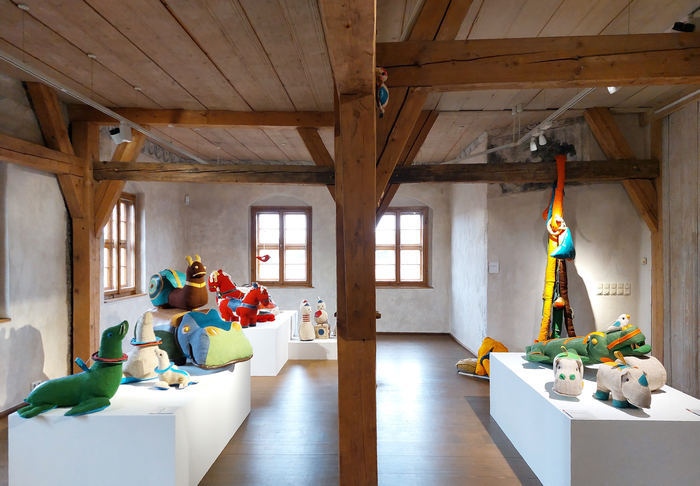
Born on October 24th 1945 in Sonneberg, Thüringen, a town renowned since time immemorial for its toy-makers and its toy production industries, Renate Lindemann counts, somewhat invariably, as a scion of a toy-making/production dynasty: her maternal grandfather, Friedrich Engel, having played an important role in establishing the reputation and commercial success in the early 20th century of the company H.J. Leven, a producer of, let's say, very traditional dolls, but also, as the cuddly cow presented in Renate Müller Spielzeug + Design Sonneberg implies, stuffed toys and bears, before in the course of the 1920s and 30s Engel progressively acquired H.J. Leven from its founder... H.J. Leven. And subsequently bequeathed it to his daughter Hildegard and her husband Emil Lindemann, Renate Lindemann's parents.
A family firm, a dynasty, Renate Lindemann joined in 1967 following the completion of her studies at the Fachschule für Spielzeug, Technical College for Toys, in Sonneberg, an institution with a (hi)story of training toy-makers almost as long as Sonneberg's (hi)story of toy-making.
And a Fachschule für Spielzeug where Renate Müller Spielzeug + Design Sonneberg's main narrative opens.
For although Renate Müller's name features prominently in the exhibition title, Renate Müller Spielzeug + Design Sonneberg isn't only about Renate Müller, it is also about the menagerie of hippos, ducks, elephants, turtles, crocodiles, et al she has nurtured over the decades in Sonneberg.
A menagerie of hippos, ducks, elephants, turtles, crocodiles, et al that greet you on the first floor of Wasserschloß Klaffenbach and accompany you up to the second floor.
A menagerie of hippos, ducks, elephants, turtles, crocodiles, et al that are quickly explained: wood wool, hessian, leather. (Occasionally a bit of wood.) But an explanation, a description, that simply can't begin to do justice to the individual characters. Nor to their relevance and importance.
A menagerie of hippos, ducks, elephants, turtles, crocodiles, et al whose rise and development is as much part of Renate Müller Spielzeug + Design Sonneberg as the personal introduction to them Renate Müller Spielzeug + Design Sonneberg enables.
And a menagerie of hippos, ducks, elephants, turtles, crocodiles, et al who have their origins in Sonneberg's Fachschule für Spielzeug.
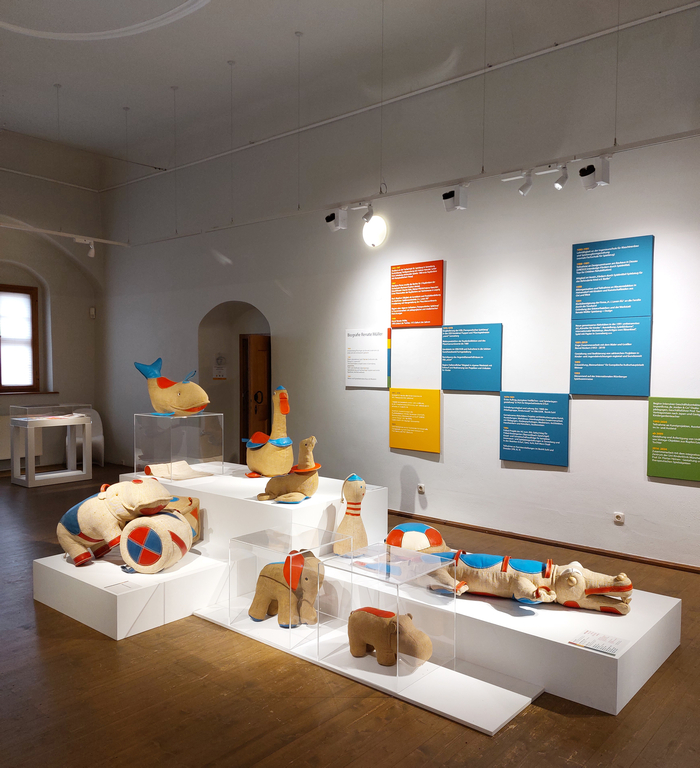
Specifically in the the class of Helene Haeusler, a creative born in 1904 in Metz, then part of the German Empire, today France, who, after a period of training in Kassel, Hamburg and Munich undertook a number of roles in the Sonneberg toy industry during the 1920s and 30s before moving to Munich in 1934 to continue her career. A Munich she remained in until returning to Sonneberg in 1954, a not uninteresting year to move from Bayern to Thüringen.
A Helene Haeusler who had not only a very theoretical approach to toys, to toy design, whose relationship with toys was often that of the detached, academic, observer, but who also had a very acute appreciation of the nature of relationships between toys and children, of toys as both a method of approaching the world around us, as conduits to developing methods of relating to and interacting with all that which as child you cannot comprehend, of play as being more than playing, and who also understood toys as being more than the sum of their parts, as having a depth beyond the superficial. Or having a depth beyond the superficial if properly designed and realised.
The latter, inarguably, being closely related to her reflections on the simple, vernacular, handmade toys that were be found being traded at village fairs of yore, objects which for Haeusler 'posses a certain cognitive derangement'3 and also "besaß jene wohl einkalkulierte Imponderabilität", 'possessed an inherent imponderability', one of our all-time favourite phrases, and by which Haeusler meant, were objects that 'didn't reveal themselves immediately, but through play'4, that became 'alive in the hands of children'.5 The position that a toy isn't until a child takes it in their physical and mental possession. A not irrelevant position on a necessity of leaving space for the user to complete the object in context of the contemporary design of all goods for not just children but for adults. And, in context of architecture and urban planning, design for communities.
A Helene Haeusler who in the early 1960s presented her students at Sonneberg's Fachschule für Spielzeug with hessian sacks used for storing and transporting sugar beet, and set the brief to make toys out of the not only unfamiliar, but unfamiliar to work with, material. Among the results was a number Rupfentiere, Hessian Animals, to give them that popular name we very much approve of. Rupfentiere whose simplicity of materials and production echo those simple village fair toys that so influenced and informed Haeusler; and early experiments with the breeding of Rupfentiere at the Fachschule für Spielzeug from which family Lindemann acquired the rights to produce three expressions thereof: a rhinoceros by Gudrun Metzel, a duck by Elfriede Fritsche and a dice by Helene Haeusler. The latter not technically an animal. But also very much an animal.
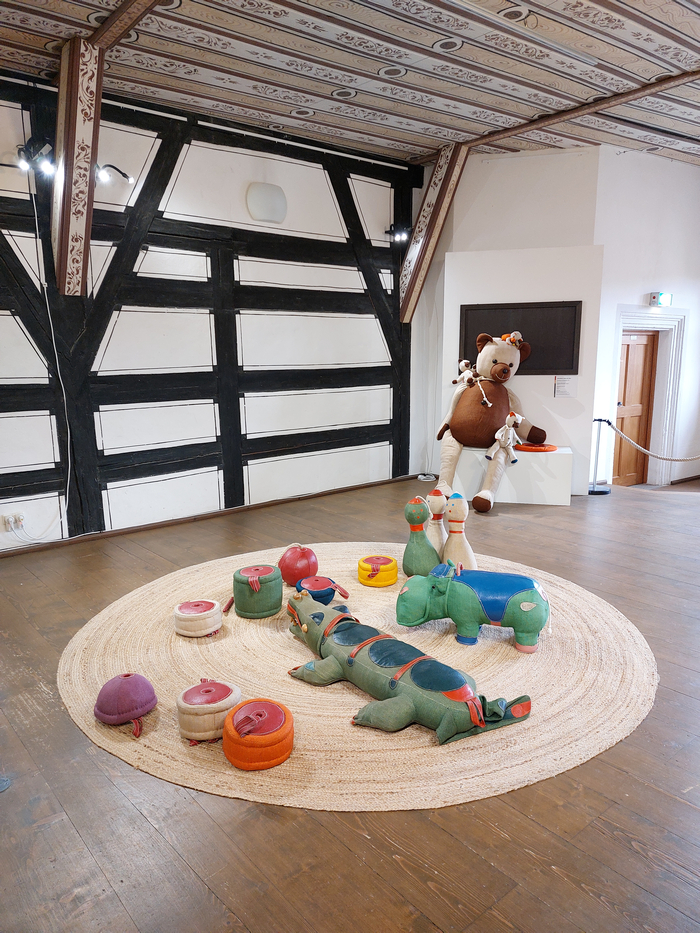
A trio of Sonneberg Rupfentiere H.J. Leven formally launched at the 1967 Herbstmesse in Leipzig. A fledgling menagerie Renate Lindemann, after 1968 Renate Müller, quickly added to in the form of, and amongst others, a turtle, an elephant or a hippo, before in 1972, and somewhat inevitably in context of late 1960s/early 1970s DDR, H.J. Leven was forcibly, compulsory, nationalised: the start of a DDR typical odyssey over ever changing company affinities, legal forms, methods of official interference and names, those things that make tracing the (hi)stories of companies through the DDR so irritatingly difficult.
Albeit an odyssey that for Renate Müller ended in 1976 with her admission to the Verband Bildender Künstler der DDR, the Association of Visual/Fine Artists of the DDR, and thus the right to work as a self-employed, freelance creative. A rare privilege amongst creatives in the DDR, and an even rarer privilege amongst designers. Thus membership of the Verband Bildender Künstler der DDR, VBK, that wasn't easy to come by, that became even harder to come by as the DDR aged, and a privilege that over time was ever more restricted, devalued, controlled by the authorities; a Karl Clauss Dietel, himself a long, long-time VBK member, using the term "Ghettopolitik" in 1981 to describe the authorities attitude towards the VBK.6 An antagonism towards the VBK on the part of the authorities, arguably, because the DDR authorities, certainly the DDR design authorities, much preferred to have creatives within the formalised control of a company collective, and of the official organs of the DDR. Not freely doing their own thing as they saw fit.
A right to self-employment Renate Müller grasped, establishing her own workshop in Sonneberg independent of that which the family business had become in the fickle hands of the DDR authorities.
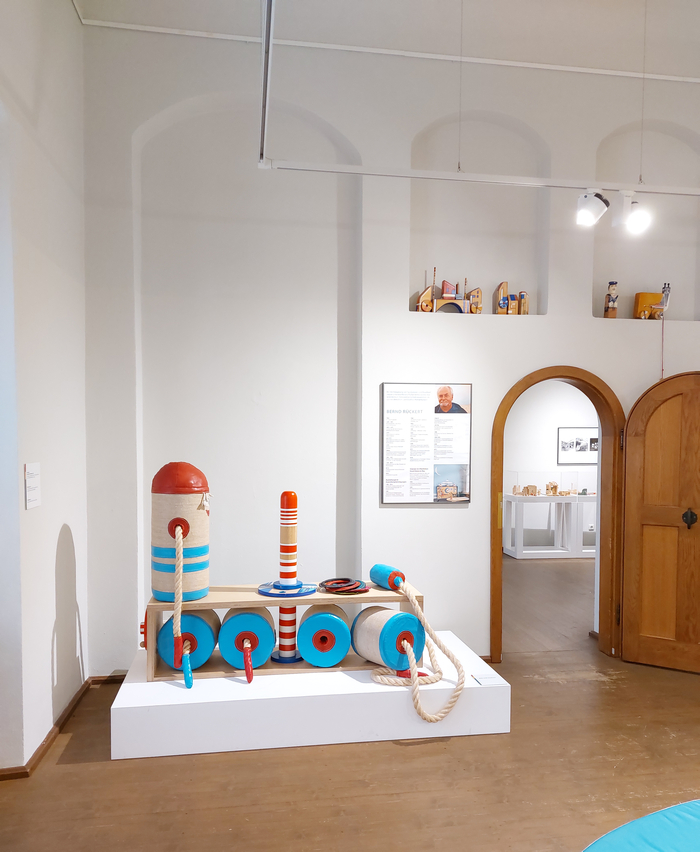
An independent workshop that while it meant she lost control of the family menagerie, a grouping that following the enforced nationalisation Müller had expanded through the addition of, and amongst others, a whale and a crocodile, saw Müller continue to nurture Rupfentiere of various genera, including what is referred to in Renate Müller Spielzeug + Design Sonneberg as a Langes Pferd, Long Horse, which it is, a very long horse. And also saw her further develop the positions and ideas inherent in the Rupfentiere in objects that aren't animals, but, much as with Helene Haeusler's dice, very much are, including, for example, a modular multi-functional toy system from 1982 that for all it is a collection of geometric forms in a spectrum of colours, which, yes, sounds like a Bauhaus project, or a Verner Panton project, is also a Rupfentier.
An independent workshop from which Müller also develop a series of, primarily, textile, but not hessian, based dolls including the so-called P-Puppen family from 1977/78, where the individual dolls' dark skin tone very much sets them apart from the almost exclusively white/pink dolls offered (to young girls) across Europe in the 1970s and 80s, offered (to young girls) across Europe since time immemorial. Thus allowing instructive insights on how toys are not only active elements of growth and development but subconsciously impact on a child's understanding of the structure and being of that society which they are growing into. That mediation of information via toys isn't in itself naturally positive. See also gender affirmation of toys and gender colour coding of toys.
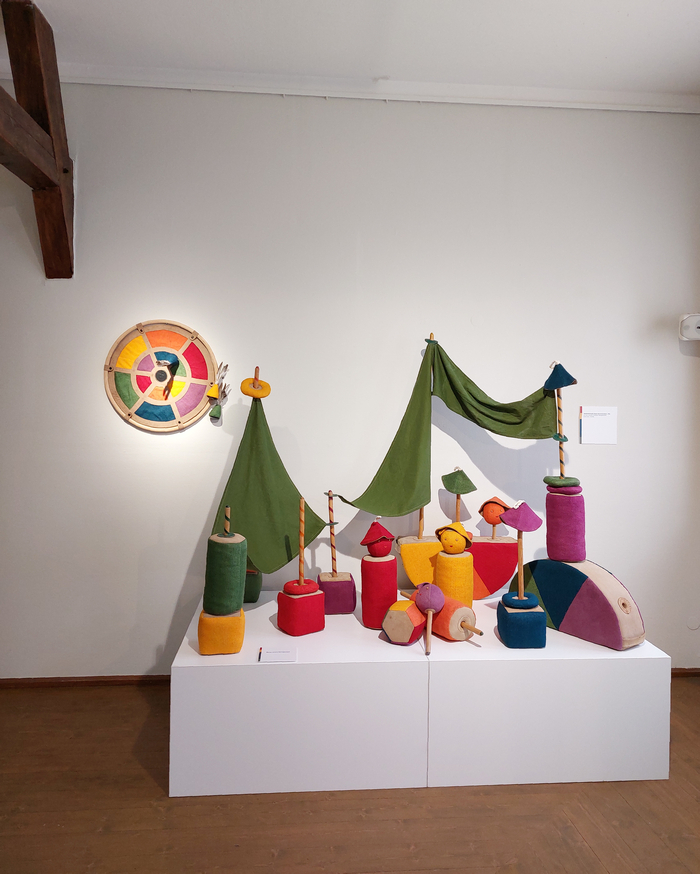
And an independent workshop in Sonneberg that also enabled, empowered, Renate Müller to further expand and develop the spheres in which she was creative; a freeing from the constraints of the formalised DDR economy that enabled her to expand her contribution to the development of design in the DDR, and the development of the DDR via design. And the development of Renate Müller. A contribution, and a professional development, that, as Renate Müller Spielzeug + Design Sonneberg neatly elucidates was closely concerned with the realisation of interior design projects for public/civic spaces in context of children, and also the design of public playgrounds. The latter represented by, amongst other projects, a mid-1980s plan for a playground in the, then, Julian-Marchlewski-Strasse in the, then, Karl-Marx-Stadt; the former being particularly neatly illustrated via the plans for and objects from Müller's 1985/86 design for a combined seating and play system for Pionierhaus Bruno Kühn in Oberhof, one of innumerable state sponsored/controlled children's holiday camp locations in the DDR. A combined seating and play system that for all it was site specific is universal in its applicability, and a concept that, inarguably, is as valid today as it was then.
And an expansion and development that also saw Renate Müller begin teaching at her Alma Mater, now renamed the Ingenieurschule für Maschinenbau und Spielzeugformgestaltung, the Engineering School for Mechanical Engineering and Toy Design, and also saw her co-found, and subsequently lead, the so-called Kindumwelt group within the VBK. A title that is a play on wider ideas of 'children’s environment', and a group we're struggling to find verifiable information on but that appears to have been nationally and internationally active both as a platform for discussion on the demands of developing child supportive environments and as an active developer of environments for children, and supportive of children.
Then came 1989. Then came 1990. And then came 1991 and the return of not just H.J. Leven to its rightful owners, but the return of the full menagerie of hippos, ducks, elephants, turtles, crocodiles, et al to the care and nurturing of Renate Müller.
And since when, as Renate Müller Spielzeug + Design Sonneberg allows one to appreciate, not least via introductions to projects realised in, for example, Munich, Jena or Sonneberg, Renate Müller has continued to develop those aspects she began within the context of her independent workshop in the DDR. And also to further develop and nurture her menagerie, both the animal-animals of the menagerie and the non-animal-animals.
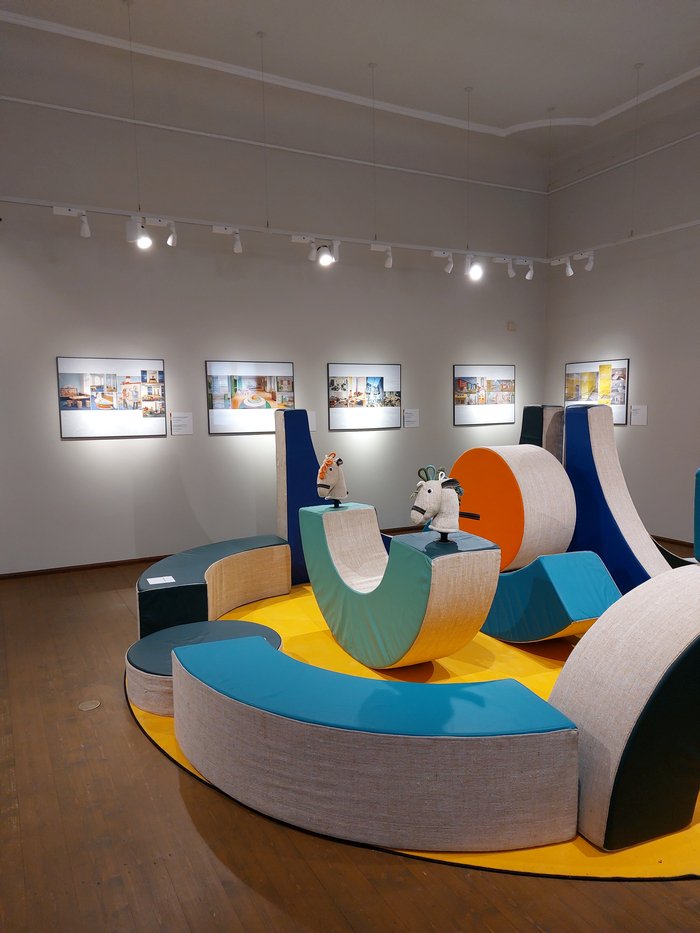
A chronological and thematic exhibition that isn't overly strictly either chronological nor thematic, rather freely mixes the two narrative possibilities to a coherent, easily comprehensible, whole, Renate Müller Spielzeug + Design Sonneberg makes pleasing use of the exhibition space in Wasserschloß Klaffenbach, including neatly, and subject appropriately, employing the exposed wood construction of the upper floor as a natural extension of the space. Is an exhibition design that employs the available space in its 3D entirety rather than as the extended 2D space most exhibitions exist as; uses the available space as any child would use it if left to their own devices. Without an adult saying, no!
A presentation that isn't just the Rupfentiere but also features, in addition to exhibits associated with the aforementioned indoor and outdoor play areas, rug designs by Renate Müller including Vögel, Birds, from 2016 a work for which the word 'joy' appears painfully insufficient, or Universe I, also from 2016, and where you can see the long tradition of classic colour theory being actively reflected on and interrogated, a work from which not only Bauhaus Weimar sends its best regards, but also Pythagoras, Goethe, Ostwald, Panton, and a thousand others from across the centuries; or a mid-1980s modular construction system for public space furniture, utensils and children's play equipment, that, as one immediately recognises, is essentially a modular toy construction kit at an urban scale, and which means that aside from being viewed as the proposal for modular outdoor furniture it is, it must also be viewed in context of the relationships between the world of children and the world of adults. Thus a component of the argument made by and from Design for Children at the Bröhan Museum, Berlin, that it might be beneficial if adults approached the world less as adults and more as children. And by extrapolation that for all adults design for children, there are also advantages in children designing for adults.
Or an idealised implication of Renate Müller at work, of Renate Müller the practising artisan, via a recreation of aspects of her workshop in Sonneberg, complete with tools, materials, furniture and Rupfentiere in need of various treatments; a reminder that Renate Müller's animal-animal and non-animal-animal Rupfentiere are produced by her, by hand, in Sonneberg. That the exhibition's full title should be, Renate Müller Spielzeug + Design + Craft Sonneberg.
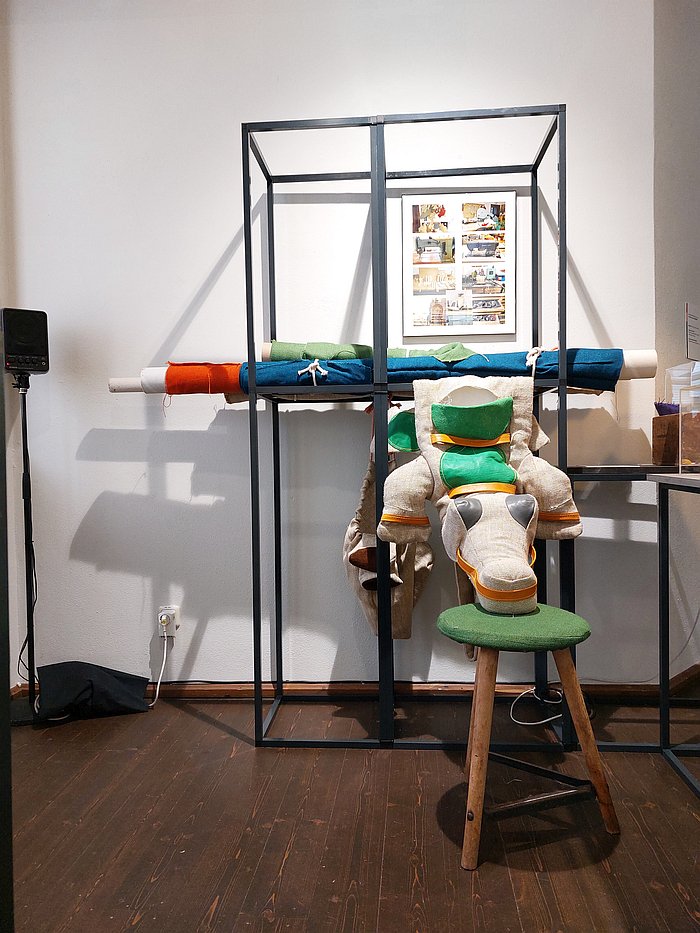
A presentation that thus allows access to Renate Müller beyond the Rupfentiere with which she is regularly, and correctly, associated. An introduction that aside from elucidating the variety and scope of both her creative practice and her roles in organisations and associations, also allows access to some of the positions and persons, beyond her immediate family, that inform her positions and approaches. Not least Friedrich Fröbel, a near-ish geographic neighbour from Oberweißbach, a formative protagonist of pedagogic activity in early childhood, of active play as a key component of development, of active play advancing not just tactile and motor but cognitive and emotional faculties; and an influence of Friedrich Fröbel on Renate Müller that, arguably, can be traced back to Helene Haeusler, herself a student of Fröbel's teachings and positions. Thus a Friedrich Fröbel who also allows Renate Müller Spielzeug + Design Sonneberg to stimulate a comparison of the reform pedagogic movements of the 19th century as developed and advanced by Friedrich Fröbel, with both the reform pedagogic movements of the 1920s and 30s which informed a Helene Haeusler's formative professional years and the reform pedagogic movements of the 1960s and 70s which informed Renate Müller's formative professional years.
A presentation that allows access to Renate Müller's international reception since 1989: the aforementioned rugs, for example, being originally presented by New York based gallery R & Company in context of the 2017 Venice Biennale, and also being presented by R & Company in context of Design Miami.Basel, while the combined seating and play system for Pionierhaus Bruno Kühn was a component of the 2012 Museum of Modern Art, MoMA, New York exhibition Century of the Child. Amongst other international presentations of her work in international contexts that help reinforce the internationally relevant nature of that which Renate Müller developed in Sonneberg.
A presentation that also allows for alternative perspectives on creative industry in the DDR. Quite aside from allowing indirect access to the consequences of the enforced nationalisation of a family business, of a family craft business, the sort of business that is as much a part of the family as the human members, whereby a bit more direct access to the consequences would be welcome, for all that, unhappily, invariably involves publicly encroaching on private, personal feelings and fates, Renate Müller Spielzeug + Design Sonneberg also allows access to the differences between, the tensions between, independent creativity as expressed by members of the VBK and that creativity which was practised within industrial collectives. A subject worthy of its own exhibition but which one can begin to approach through the person of Renate Müller. Should, must, begin to approach.
But a presentation that is also very much the Rupfentiere.
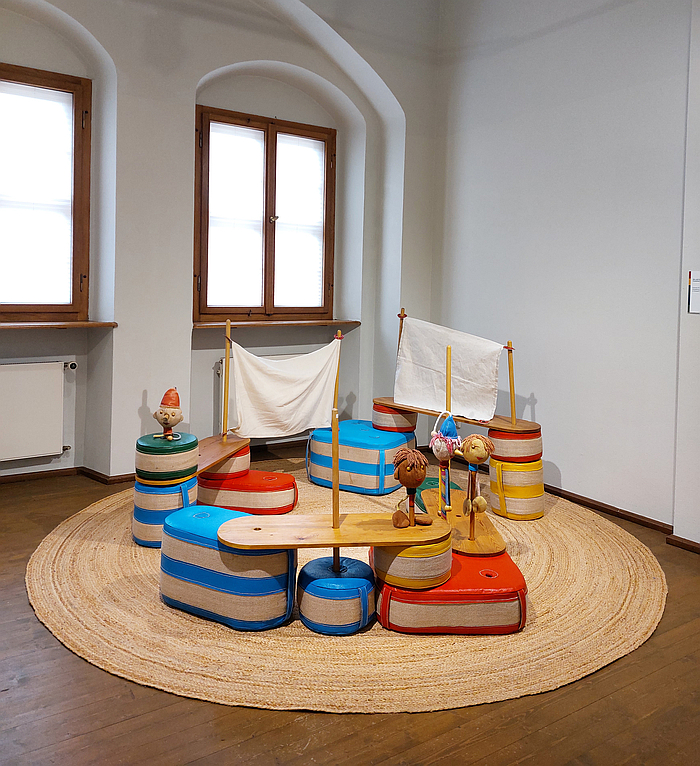
Creatures, as noted above, quickly explained but who are so much more than that quick description, so much more than Holzwool, Rupfen and Leder, wood wool, hessian and leather.
Creatures that aren't just animals, aren't just stuffed toys in the long Sonneberg tradition, alone their mix of hessian and wood wool means they not only stand physically far removed from the stuffed toys of Sonneberg, but stand conceptually far removed from that which a stuffed toy conventionally is, why a stuffed toy conventionally is, while very much being objects to embrace.
Or perhaps more accurately, individuals to embrace: as one quickly learns in Renate Müller Spielzeug + Design Sonneberg they are all individuals, are all vital characters who actively communicate with you, approach you, engage you in conversation, but are never pushy or intrusive, are always respectful of what you want, what you need, who you are.
Nor are they just toys; rather, they very much are toys, but they are also therapeutic toys, toys, tools, for medical and care contexts relative to children; characters for situations which require practitioners of all types with qualities and skills beyond a technical, scientific competence. Require individuals who are never pushy or intrusive, are always respectful of what you want, what you need, who you are.
And are also furniture. Are objects for sitting on, lying on, standing on, for finding a physical place of comfort, and an emotional place of comfort, be that in a familiar room at home or in a room in an institution you'd probably rather not be in. And thus, in context of the later space, provide a physical and emotional location for setting a child at ease in a naturally stressful situation. That reason why actual animals often make visits to children's wards.
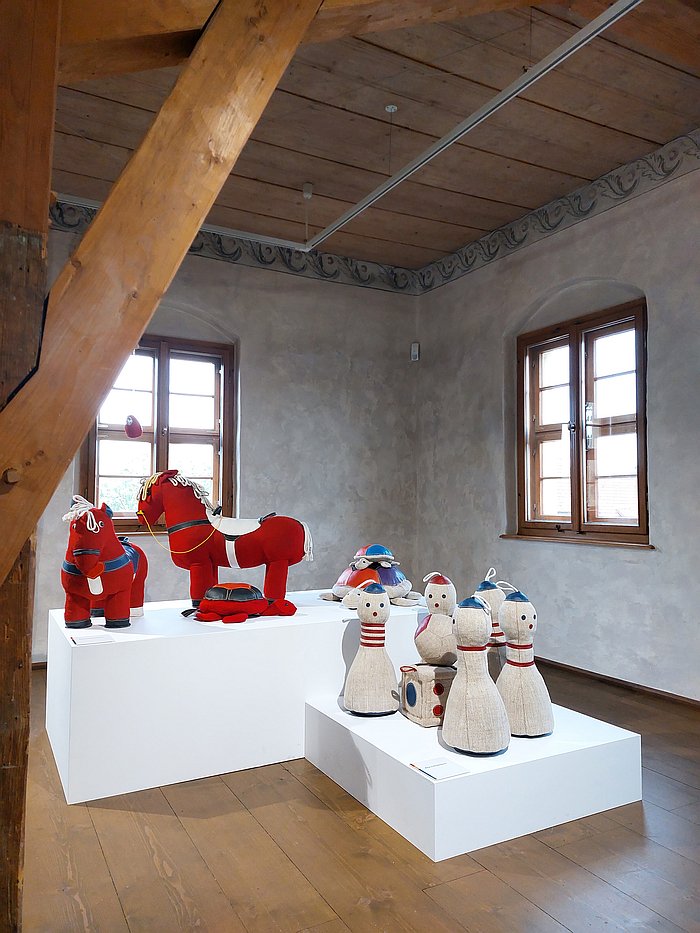
Therapeutic toys, therapeutic tools, which is and was the reason for their genesis in Helene Haeusler's class in the early 1960s at Sonneberg's Fachschule für Spielzeug, and is very much how family Lindemann presented them to the public: Renate Müller Spielzeug + Design Sonneberg featuring a, sadly undated, poster from an H.J. Leven presentation at, one presumes from the objects listed, an early 1970s Leipzig Messe, that features a review of the use of H.J. Leven's Rupfentiere with children, with a variety of conditions, in a clinical situation, by Dr Werner Kressin, Senior Consultant at the Städisches Klinikum Berlin-Buch, that attests them as a "besonders wertvolle Bereicherung", 'particularly valuable enrichment' across a use spectrum from "toys for healthy children to therapeutic aids for physically and mentally disabled children", whereby language is always specific to its era. A "besonders wertvolle Bericherung" that, according to Dr Werner Kressin, who we see no reason to doubt, arises not only from the "form and 'good-natured' expression of the animals" but also from the materials used and the various additions that adorn each individual and expand them in context of the mode of action, their "Imponderabilität"; additions, adornments which serve as stimulation, inspiration, motivation, are components of the individual Rupfentiere becoming 'alive in the hands of children'.
Therapeutic toys, therapeutic tools, that are also, primarily, toys, which is very much how Renate Müller developed them over the decades, both as animal-animals and as non-animal-animals. Renate Müller Spielzeug + Design Sonneberg allowing one to appreciate how Müller took the basics of those first Rupfentiere, the considerations and discussions from Helene Haeusler's class at the Fachschule für Spielzeug, and worked with them over the decades, developed them over the decades.
Or put another way, viewing Renate Müller Spielzeug + Design Sonneberg is to appreciate and follow various recurring details and conceits across apparently unrelated projects, including, for example, and amongst many others, a pluggability, an analogue plug'n'play systematic that, arguably, has been a basic of toy design as long as toys have been made in Sonneberg, but that in Müller's work not only aids a multi-dimensionality but allows for the easy integration of objects that offer a variety of modes of interactions in one compact system; or simple yet efficient joining systems, joints that while straightforward for adult eyes and hands have to be learned, comprehended, mastered by children’s eyes and hands, joints we can well imagine a Friedrich Fröbel would approve of; or an "einkalkulierte Imponderabilität", nothing on show explains its mode of use, explains what is, how it is, why it is, if it is... OK, arguably the rugs do, but everything else can only be defined, can only begin to understand its function, through personal exploration; or an inter-connectability, something inherent in the many modular systems but also the works that apparently stand alone, don't, are part of a wider whole.
Or a strong graphic quality, we're not saying cartoon-esque that would be wrong, but the animal-animals and non-animal-animals are objects you engage with graphically as much as physically and emotionally, a graphic quality that isn't automatically given by form and colour but that is intimately related with the genesis of the objects, is an animation Renate Müller bequeaths otherwise inanimate objects. Is a component of Müller's 'emotion' as expressed through her work.
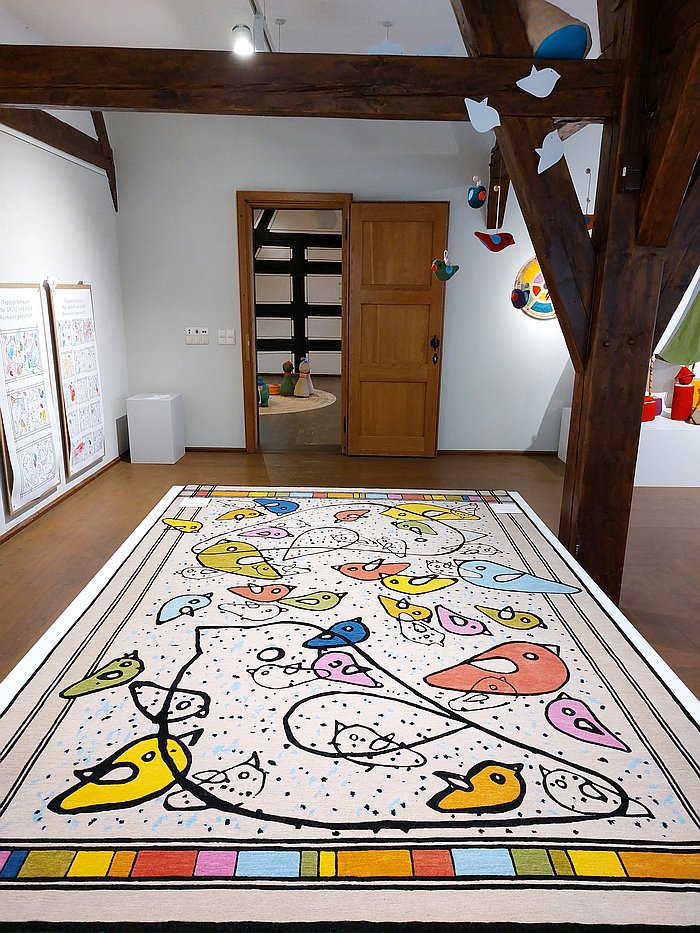
Toys, therapeutic toys, that thus can not only teach us a lot about interactive design, about how one approaches questions of creating intuitive, communicative, open objects whose being arises through use, nor that can only teach us a lot about functionality beyond the purely physical that so often, and so incorrectly, is the focus in context of our objects of daily use, but that can also teach us a lot about designing for series, about designing frameworks and structures that enable, empower, further development and movement of principles in new directions, rather than reinventing the wheel afresh with every project. A principle that, arguably, can also be found in the work of, for example, a Charles and Ray Eames, a Michael Thonet or the numerous Shaker communities.
A contribution by Renate Müller to design discourses, a contribution by Renate Müller to the development of design, that while it can be read and engaged with in context of Renate Müller Spielzeug + Design Sonneberg, and while, as noted above, has been internationally acknowledged since 1989, wasn't always acknowledged in the DDR: the DDR's most important design magazine, Form+Zweck, largely ignored Renate Müller, and in context of the Rupfentiere tended to give Helene Haeusler a more prominent role than Müller, or, for example, in context of the Rupfentiere's receipt of a 1978 "Gutes Design" Award, giving equal billing to Haeusler and Muller.7
And while Haeusler's role in their genesis, their conceptual and physical genesis, is not unimportant, see also the number of references we're making to Haeusler, the fact we can't write about Renate Müller Spielzeug + Design Sonneberg without referring to Haeusler, nor is Haeusler's role in the development of the Sonneberg toy industry in the DDR unimportant, while Haeusler's role in the development of therapeutic toys in Sonneberg, and in the DDR, is of central importance: but after 1967 the Rupfentiere are Müller's work. That needed to be acknowledged by Form+Zweck. Then there is the question why Form+Zweck so ignored Müller's interior and spatial design for children, and her non-animal-animals. Works, projects, of which we can find no mention.
Why?
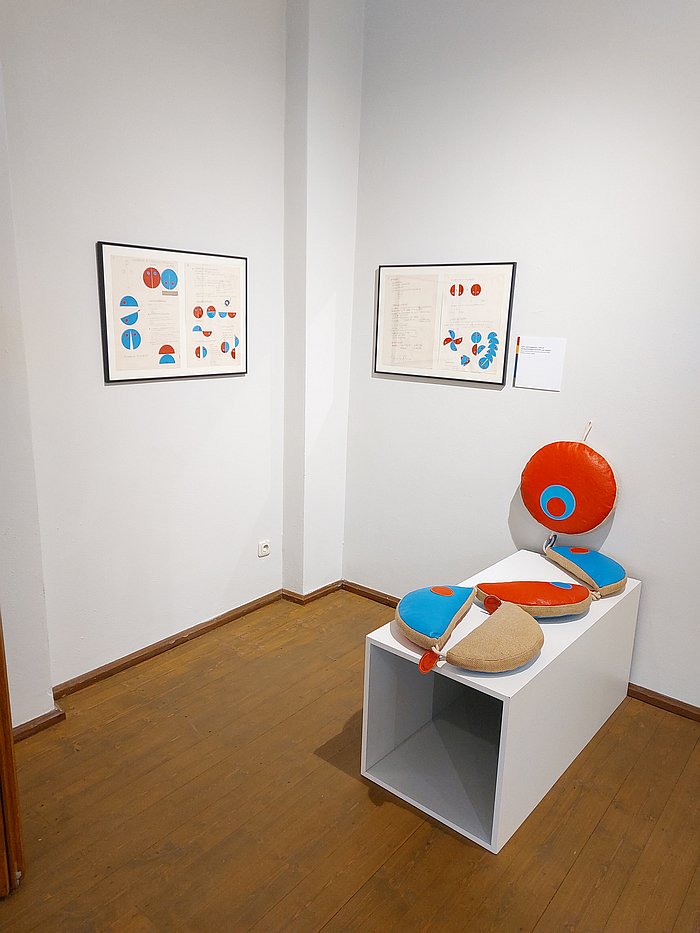
We no know.
And Renate Müller Spielzeug + Design Sonneberg sadly doesn't approach possible answers. But which may be related to Müller's independence through her membership of the VBK. Or may not be. The question is still very much open. At least for us. Others, as ever, will know.
And in many regards more important is that the works, projects, positions, contributions are today there for us all to appreciate, engage with, critically assess, and that, as Renate Müller Spielzeug + Design Sonneberg tends to admonish, that Renate Müller, can, should, must, be allowed to contribute to our contemporary, and future, design discourses.
Which brings one to that other question Renate Müller Spielzeug + Design Sonneberg doesn't approach: a review of the results of the past 60 years is all well and good and welcome, entertaining and instructive even. But what of the future?
Not necessarily the future of a craft based practice, one in which the primary, the only, artisan, as with all of us, isn't getting any younger. Although that question is, if not necessarily easy, then certainly valid.
But rather, Renate Müller Spielzeug + Design Sonneberg tends to argue that Müller's animal-animal and non-animal-animal Rupfentiere, Müller's approaches and positions, have a future; or perhaps better put, tends to argue that are as contemporary today as they have always been.
But will they always be?
On the one hand, no AI, no algorithm, no technology can ever replace Renate Müller's Rupfentiere. But on the other hand, only as long as human society is based on 'human emotion', involves a primacy of heart, love and understanding.
If it isn't, if it doesn't, who needs a menagerie of hippos, ducks, elephants, turtles, crocodiles, et al?
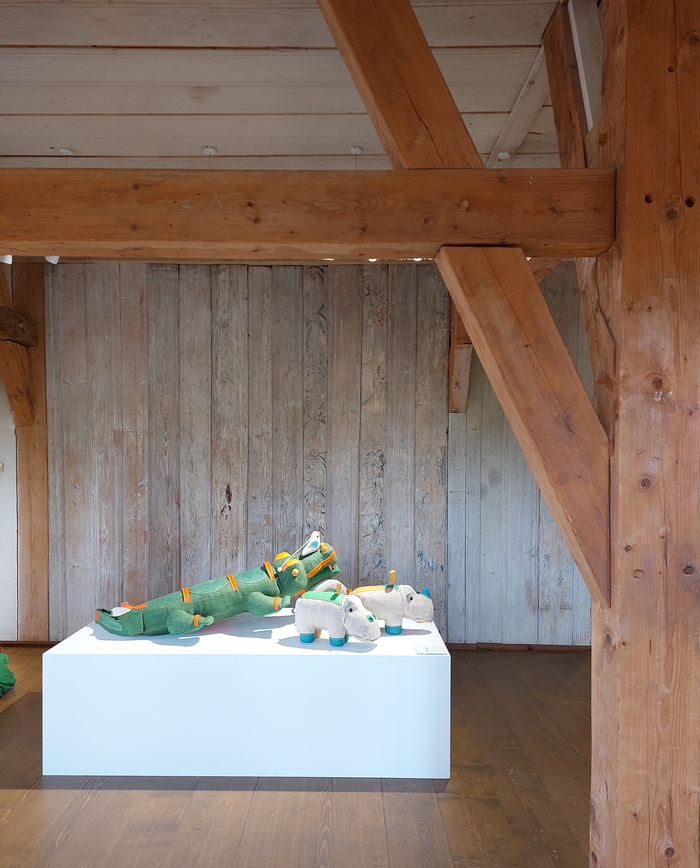
Thus the question of how the story develops from the 2025 in which Renate Müller Spielzeug + Design Sonneberg ends is also a question of how we want society to develop.
Does the menagerie of hippos, ducks, elephants, turtles, crocodiles, et al become expensive collectors items and objects for museum vitrines, objects from the past without a contemporary voice, or do we want them, that which they represent, that which they embody, that which they offer, as active, vital companions?
Renate Müller's menagerie, and Renate Müller's spatial design for children, are dependent to a large degree on the inquisitiveness and curiosity of the child, on providing space and opportunity for that inquisitiveness and curiosity to unfold as the child sees fit, and to a degree the child is comfortable with, viewing Renate Müller Spielzeug + Design Sonneberg one begins to appreciate that. By its very nature AI replaces human imagination, intelligence, inquisitiveness and curiosity: does things for you that inquisitiveness and curiosity have thus far not only seen you achieve but through doing so has brought you places, exposed you to vistas, you didn't know existed and that AI can't see; renders active, probing intelligence static, passive; petrifies imagination. With AI there is no "Imponderabilität", no room for "Imponderabilität", "Imponderabilität" is frowned upon in AI society.
For all that there are, without question, many excellent arguments that can be made for specific uses of AI, we don't have to fully embrace AI in all dominions; (hi)story implies we probably will nonetheless. And invariably do so unthinkingly, passively.
¿And then?
How is the role of play as a conduit to empowering children to develop methods of relating to and interacting with all that which they cannot comprehend to be designed in coming decades of ever more AI and autonomous technology? How is the role of play as a conscious and subconscious component of a child's appreciation of the structure and being of that society into which they are growing to be designed in coming decades of ever more AI and autonomous technology? How are tactile, motor, cognitive and emotional faculties to be simultaneously developed in coming decades of ever more AI and autonomous technology? How are children with tactile, motor, cognitive, emotional, developmental, et al disorders to be aided, abetted, empowered in coming decades of ever more AI and autonomous technology? How are responsive, embracing, stimulating, supportive interior and exterior spaces for children to be designed in coming decades of ever more AI and autonomous technology? ¿Childhood in coming decades of ever more AI and autonomous technology?
¿Does the menagerie of hippos, ducks, elephants, turtles, crocodiles, et al become expensive collectors items and objects for museum vitrines, objects from the past without a contemporary voice, or do we want them, that which they represent, that which they embody, that which they offer, as active, vital companions?
Renate Müller's menagerie of hippos, ducks, elephants, turtles, crocodiles, et al don't have the answers. But then answers aren't their raison d'être. That's more an allowing for space for the development of lines of inquiry.
Nor does Renate Müller Spielzeug + Design Sonneberg have the answers. Doesn't seek to provide answers, But does both allow one to appreciate the urgent need to begin to approach answers and provides a stimulating space to begin to better formulate the questions we need to pose in order to approach possible answers.
While also allowing for entertaining and instructive insights on design, toys, toy design, designing for children. And on the ongoing relevance and importance of Renate Müller in such dominions.
And, arguably primarily, offers an easily accepted invitation to spend some quality time with a menagerie of characters you can never, ever, tire of. Which arguably is the real definition of 'timeless': a component of 'human emotion'.......
Renate Müller Spielzeug + Design Sonneberg is scheduled to run at Wasserschloß Klaffenbach, Wasserschloßweg 6, 09123 Chemnitz until Sunday October 19th.
Further details can be found at www.c3-chemnitz.de (German only)
A series of short video interviews with Renate Müller can be found at www.stiftung-industrie-alltagskultur.de/renate-mueller (German only, or more accurately Thüringisch only)
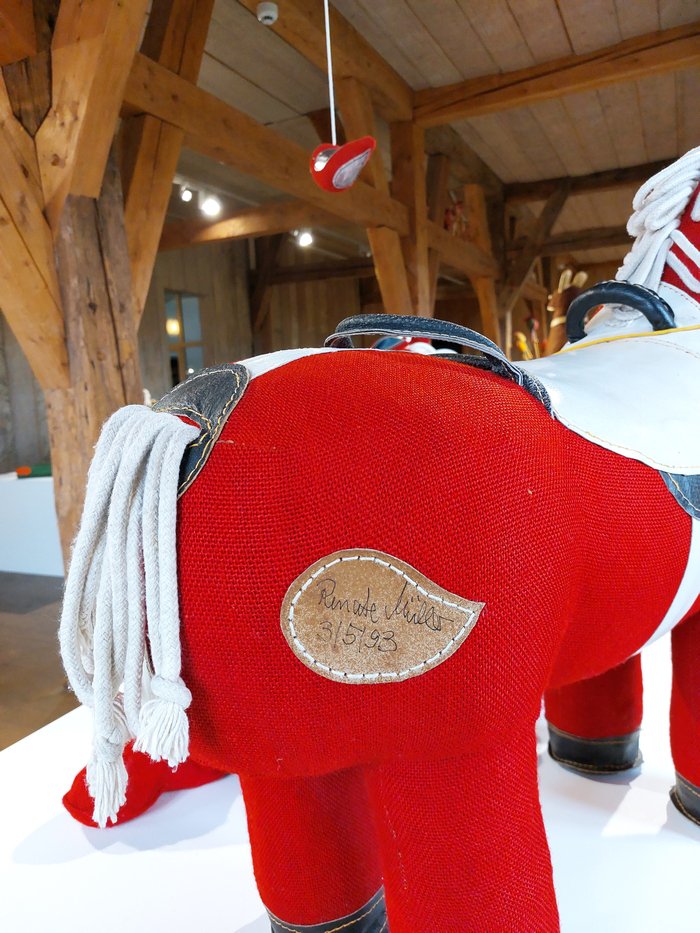
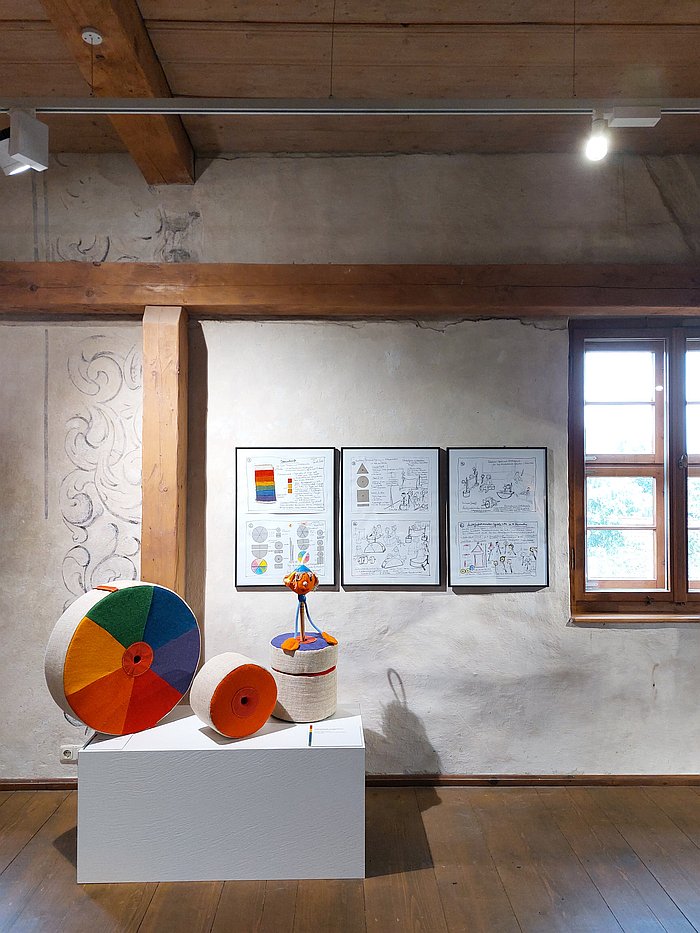
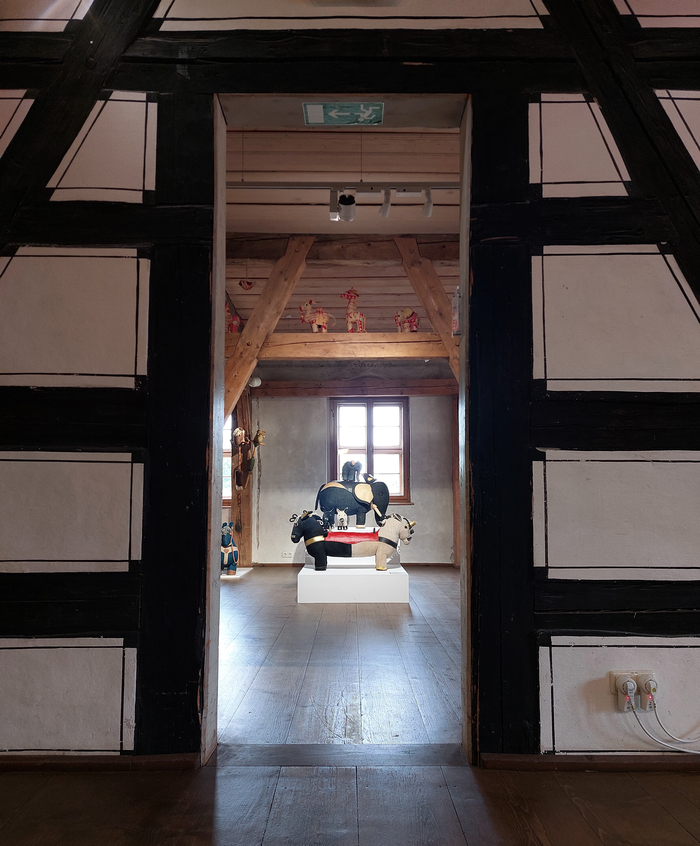
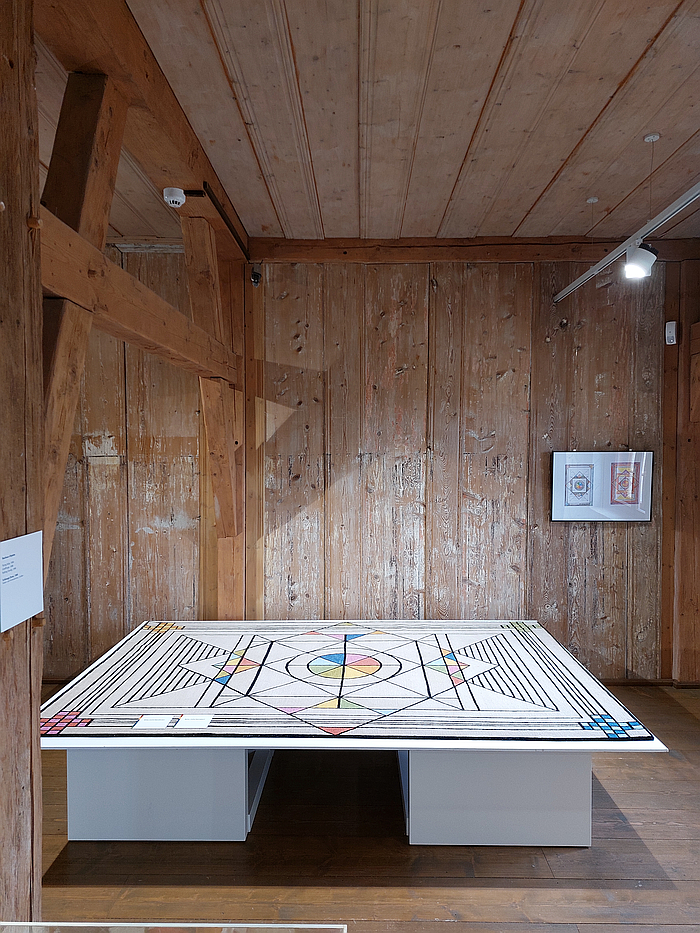

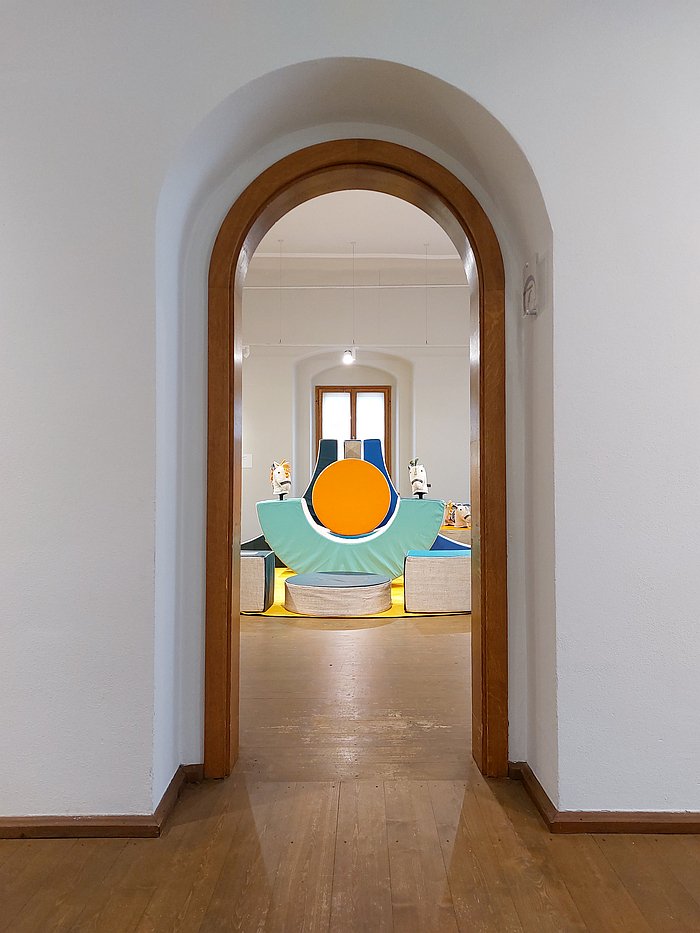

1Unreferenced quote in Renate Müller Spielzeug + Design Sonneberg ¡¡¡Always reference yout quotes!!!
2see "Spielzeuggestalterin - Beruf und Berufung", video interview with Renate Müller, available at www.stiftung-industrie-alltagskultur.de/renate-mueller
3Aphorismen zum Spielzeug von Helene Haeusler, aufgeschrieben von Hein Köster, Form+Zweck, Nr. 3, 1975, page 34/35
4ibid, page 35
5Helene Haeusle, Form+Zweck, Nr. 2, 1972, page 41
6Letter from Clauss Dietel, 22.06.1981, reprinted in Walter Scheiffele and Steffen Schuhmann, Kark Claus Dietel. Die offene Form, Spector Books, Leipzig, 2021, page 309
7see Form+Zweck Nr. 3, 1978, page 48 Form+Zweck Nr. 2, 1970, page 39-40, has an article by the aforementioned Dr Werner Kressin about therapeutic toys developed by Helene Haeusler in context of the "Entwicklungsstelle für therapeutisches Spielzeug, Sonneberg", and produced by Leven KG. It doesn't seem to be referring to the Rupfentiere, but quite possibly is. Which would be very cheeky. While in the interests of fairness Form+Zweck, Nr. 5, 1976 page 44 is positive about Müller's contribution, while reinforcing Helene Haeusler's importance. Also interesting is the article Spielgaben für Behinderte by Dagmar Lüder in Form+Zweck Nr. 6, 1980, pages 26-32, essentially a portrait of Helene Haeusler, which notes of the Rupfentiere 'The pieces manufactured today by industry have been so extensively modified that one must fear for their therapeutic value', and also, "unfortunately, the delight in the cuteness of the animals often overlooks their therapeutic meaning', thus tending to imply that in context of their care under, then, VEB Kombinat Puppen- und Plüschspielwaren SONNI, all was not well with and in the menagerie. Another subject well worthy of further investigation.